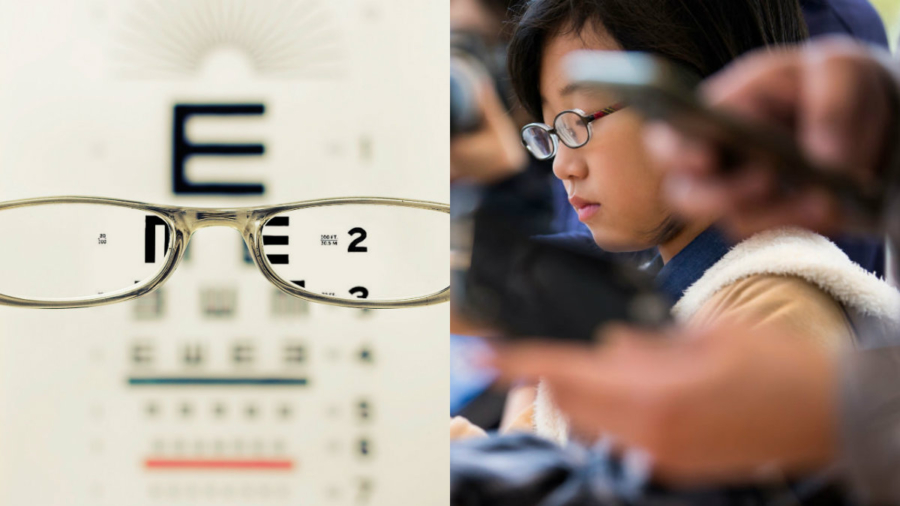The Japanese government is suggesting that smartphones may be to blame for children’s worsening vision after results from a recent national survey revealed that the prevalence of students in certain age groups who had below the standard 20/20 vision had reached all-time highs.
A preliminary report of the School Health Statistics Survey 2018 (pdf) released on Dec. 21 by Japan’s Ministry of Education, Culture, Sports, Science, and Technology, found a record 67.09 percent of high school students (years 10 to 12) and 34.10 percent of elementary school students (years 1 to 6) had an unaided vision that was below the normal 20/20 score.
Japan’s ministry said that according to experts, the alarming results are due to a rise in the time students are spending looking at screens, which is caused by their increasing use of smartphones and mobile games, Japanese news agency Jili Press reported.
Only the junior high school students did not break the record, showing 56.04 percent this year—compared to last year’s record-breaking 56.33 percent—as having vision below 20/20.
The survey results are based on the records of 3.42 million students aged 5 to 17 who took a vision test from April to June this year.
A designation of 20/20 is used to express a certain degree of clarity or sharpness of vision—also referred to as visual acuity—when measured at a distance of 20 feet (about 6 meters). Those with 20/20 visual acuity are generally considered to have “normal vision.”
‘Epidemic’ of Myopia
Those with lower than 20/20 vision may perceive objects in the distance—that is, at 20 feet or 6 meters or beyond—as blurry. This is often due to shortsightedness, or myopia. In more rare cases, reduced distance vision can be due to relatively high levels of longsightedness, or hyperopia. Reduced vision can also be due to ocular health-related issues independent of myopia or hyperopia.
Spectacles, contact lenses or refractive surgery can help those who are myopic reach an aided visual acuity of 20/20. However, even when a person achieves 20/20 vision via one of the above forms of correction, in some, the condition can still slowly progress to higher levels of myopia (-5.00 dioptres or more) which makes them much more susceptible to sight-threatening conditions, including glaucoma, retinal detachment, earlier onset cataracts, and myopic maculopathy.
One non-profit eye care research body, the Brien Holden Vision Institute, has been conducting research and providing training to eye care practitioners around the world to combat myopia since 2003. The Institute views myopia as a fast emerging public health issue.
According to the Institute, myopia is seen as an epidemic in many countries, especially those in East Asia, where some places see up to 80 percent of high school leavers—16 to 18 years old—having the condition.
The Institute’s late founder, Professor Brien Holden, headed a 2016 peer-reviewed paper in the journal Ophthalmology that predicted that half the world’s population—nearly 5 billion people—would become shortsighted by 2050, with around 1 billion of them at a significantly higher risk of blindness if no action is taken to address the situation. Currently, about 30 percent of the world’s population have myopia.
Near Work and Time Spent Outdoors
According to the general consensus in myopia research, myopia is influenced by both environmental and genetic risk factors, as well as the interplay between the two. Genes are believed to determine how susceptible a person is to become shortsighted.
According to another peer-reviewed paper headed by the late Holden, environmental factors such as increased near work and not enough time spent outdoors have been identified as contributors to myopia. Other possible contributing factors include low levels of vitamin D, inadequate light exposure, and a poor diet.
There is emerging evidence in myopia research that suggests that increasing time spent outdoors can reduce a person’s risk of becoming shortsighted, and also reduce the rate of progression in those who have already become shortsighted, according to the paper.
“Parents should also be encouraged to monitor the time their children spend on near devices and encourage time spent outdoors,” the paper states.
A previous research paper published in Ophthalmology in 2008 has proposed that public health measures be put in place to prevent children from developing myopia by encouraging them to spend more time outdoors.


